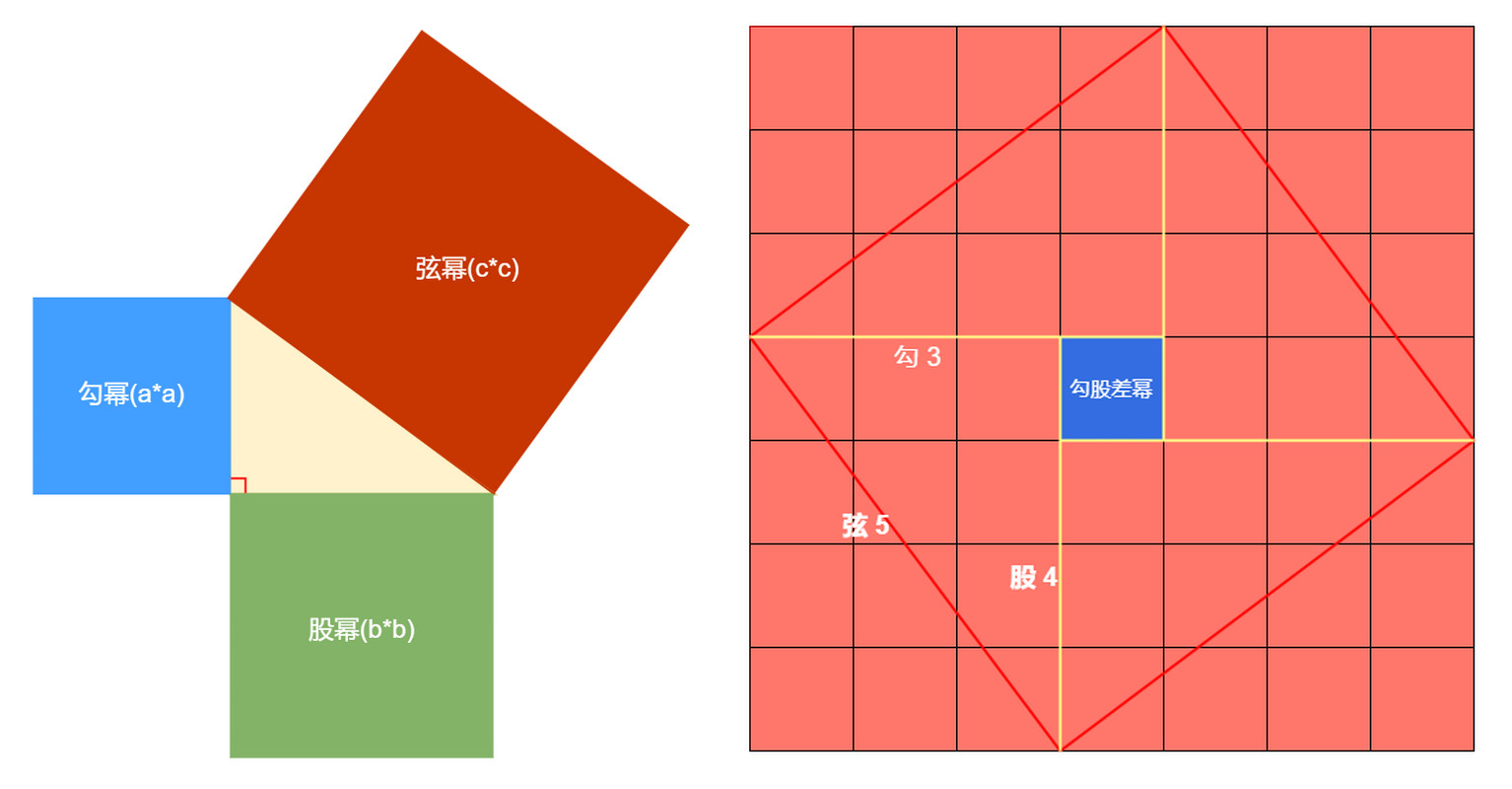The Pythagorean theorem(translation is 毕达哥拉斯定理) in ancient Chinese mathematics is called 勾股定理.
Typically, the mathematical expression we use to describe the Pythagorean Theorem is
a^2+b^2=c^2.
At the same time, we usually think of the hypotenuse of a right triangle as c, the short right side as a, and the long right side as b.
Therefore, a is shorter than b, and b is shorter than c.(a <= b, b < c)
Description of Pythagorean theorem in ancient Chinese mathematics
短面曰勾,长面曰股,相与结角曰弦。勾短其股,股短其弦。——《九章算术·勾股》
译文: 在直角三角形中,短的边称为勾,长的边称为股,与它们分别形成直角的边为弦。勾的长度比股短,股的长度比弦短。
In a right triangle, the short side is called
勾, the long side is called股, and the side forming a right angle with them is弦.
勾 is shorter than 股, and 股 is shorter than 弦.(勾 <= 股,股 < 弦)
Note that 冪 is the traditional Chinese character for 幂, and the 幂 mentioned below all refer to 冪.
勾股幂合以成弦幂variant:
合勾股幂以成弦幂
以勾股幂合成弦幂According to ancient grammar, there are two variations of this sentence, and I prefer the former.
勾represents the short right-angled side, likeain the formula.股represents the long right-angled side, likebin the formula.幂means the product of two numbers multiplied together, here denoting self-multiplication, like the concept of square in modern math.勾股幂can be understood as the omitted expression of勾幂和股幂.
合means结合, represents combine. It can be simply understood here as the sum of勾幂and股幂.以成means用来形成, representsto become/formin English..以means用来, represents the wordtoin English.成means变成or形成, representsbecomeorformin English.
弦represents the hypotenuse of a right triangle, likecin the formula.幂as above.
Origin of 幂
about 巾(towel) :
巾,佩巾也。——《说文解字》
巾 is a pictographic character.
In the oracle bone script, its glyphs resemble a piece of fabric hanging down at both ends, indicating a textile for wiping, covering, wrapping, wearing, etc., much like modern towel.
about 幂(power) :
大巾谓之幂。——《小尔雅·广诂》
幂 is a phonetic word, and its sound side is 冥, indicating that the word and 冥 have similarities in pronunciation. Its shape is 巾, indicating that the word is related to the word 巾.
According to the structure of 幂 , it can be inferred that its original meaning is a towel used to cover things. It is then derived to mean to cover(覆盖,遮掩), and from that to mean area(面积).
about 冖 :
“冖,覆也,从一下垂也。” ——《说文解字》
Cover something with a square piece of cloth and let the four corners hang down to form the shape of an 冖.
Extending this meaning, anything that is square can also be called a 幂. By further extension, the area of a rectangle(矩形)1 or the product of two numbers2(especially the result of multiplying a number by itself [3]) is also called a power. This promotion began with Liu Hui(an ancient mathematician called 刘徽 in China).
"the product of two numbers" means
两数之积in Chinese."multiplying a number by itself" means
自乘(一个数与自身相乘)in Chinese.
方田术曰:广纵步数相乘得积步。此积谓田幂。凡广纵相乘谓之幂。——《九章算术·方田》
译文 长方形田面积法则:宽与长的步数相乘得积步。(刘徽注:这个积称为田的幂。凡是长宽相乘就称为幂。)
The area rule of a rectangular field: multiply the number of steps of width and length to get the product of steps. (Liu Hui note: This product is called the
幂(power) of the field. Where length and width are multiplied together they are called幂.)
步 (step) : In ancient times, each of the two feet crossed once called step, now refers to the distance between the two feet when walking.
又,勾自乘,以减弦自乘。其余,开方除之,即股。勾、股幂合以成弦幂,令去其一,则余在者皆可得而知之。——《九章算术·勾股》
译文:计算勾的自乘数,然后用弦的自乘数减去它,把余数作开方(根号)运算,结果就是股。
Calculate the self-multiplier of the
勾, then subtract it from the self-multiplier of the弦, take the square root of the remainder, and the result is股.
[3]
自乘之数曰幂。——《几何原本》by 徐光启, 利马窦
Now back to the question.
What does 朱幂 and 黄幂 mean in this ancient illustration of the Pythagorean Theorem?
about 朱幂 and 黄幂 :
朱 means 赤色, indicate red.
朱,赤心木,松柏属。——《说文解字》
黄 here means yellow.
幂 means 自乘, its explanation is above.
As can be seen from the picture:
朱幂 = 1/2 × (勾 × 股) = 1/2 × ab
黄幂 = (勾 - 股) × (勾 - 股) = (b - a)^2
弦幂 = 弦 × 弦 = c^2
The first kind of argument:
Four congruent right triangles form a square(弦幂) with side length c, and in the middle of the figure there is a small square(勾股差幂) with side length b – a.
because:
弦幂 = 4 × 朱幂 + 黄幂
thus:
c^2 = 1/2 × ab × 4 + (b - a)^2
c^2 = 2ab + a^2 + b^2 - 2ab
finally:
c^2 = a^2 + b^2
The second argument:
Then splice four identical congruent right triangles(朱幂) outside the square(弦幂) with side length c, and you will have a square with side length a + b, which can also prove the Pythagorean theorem.
because:
(勾股差幂 + 4 × 黄幂 ) + 4 × 黄幂 = (a + b)^2
弦幂 + 4 × 黄幂 = (a + b)^2
thus:
c^2 + 4 × (1/2 ab) = (a + b)^2
c^2 + 2 × ab = a^2 + b^2 + 2 × ab
finally:
c^2 = a^2 + b^2

